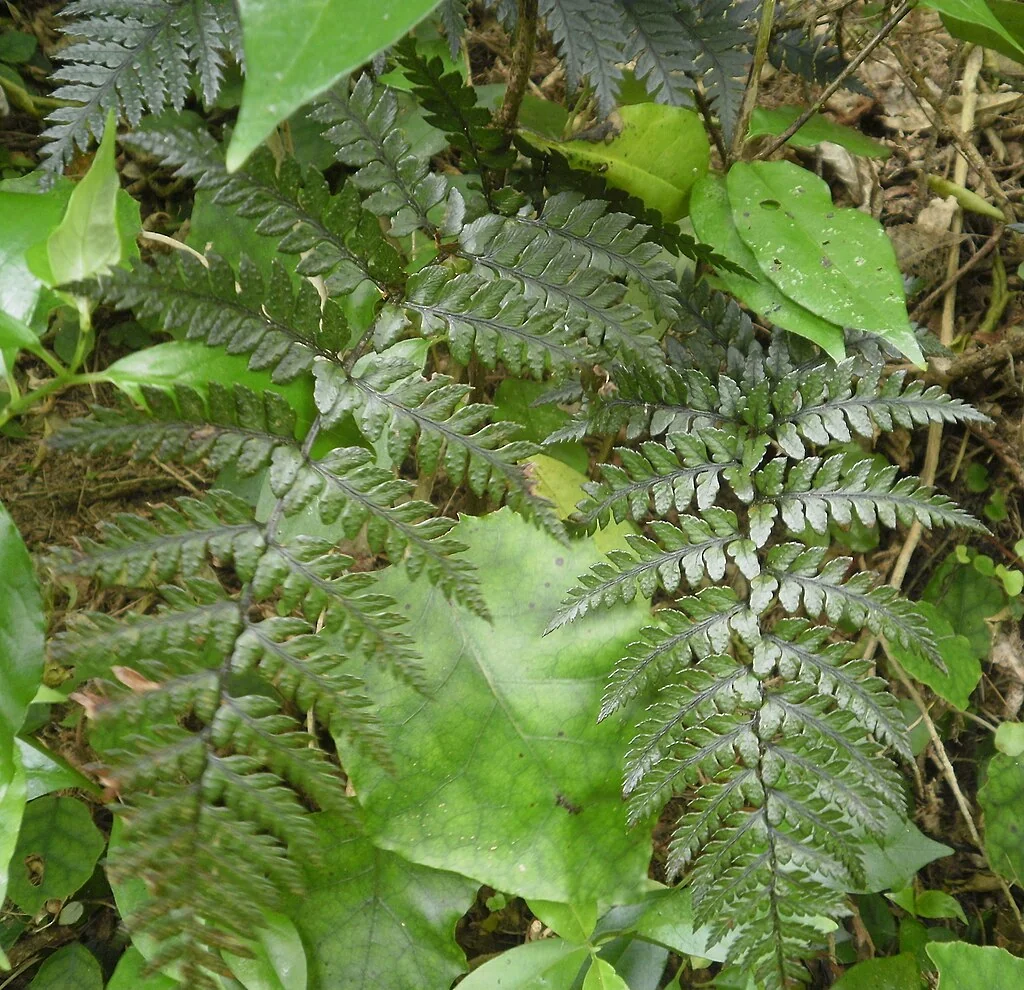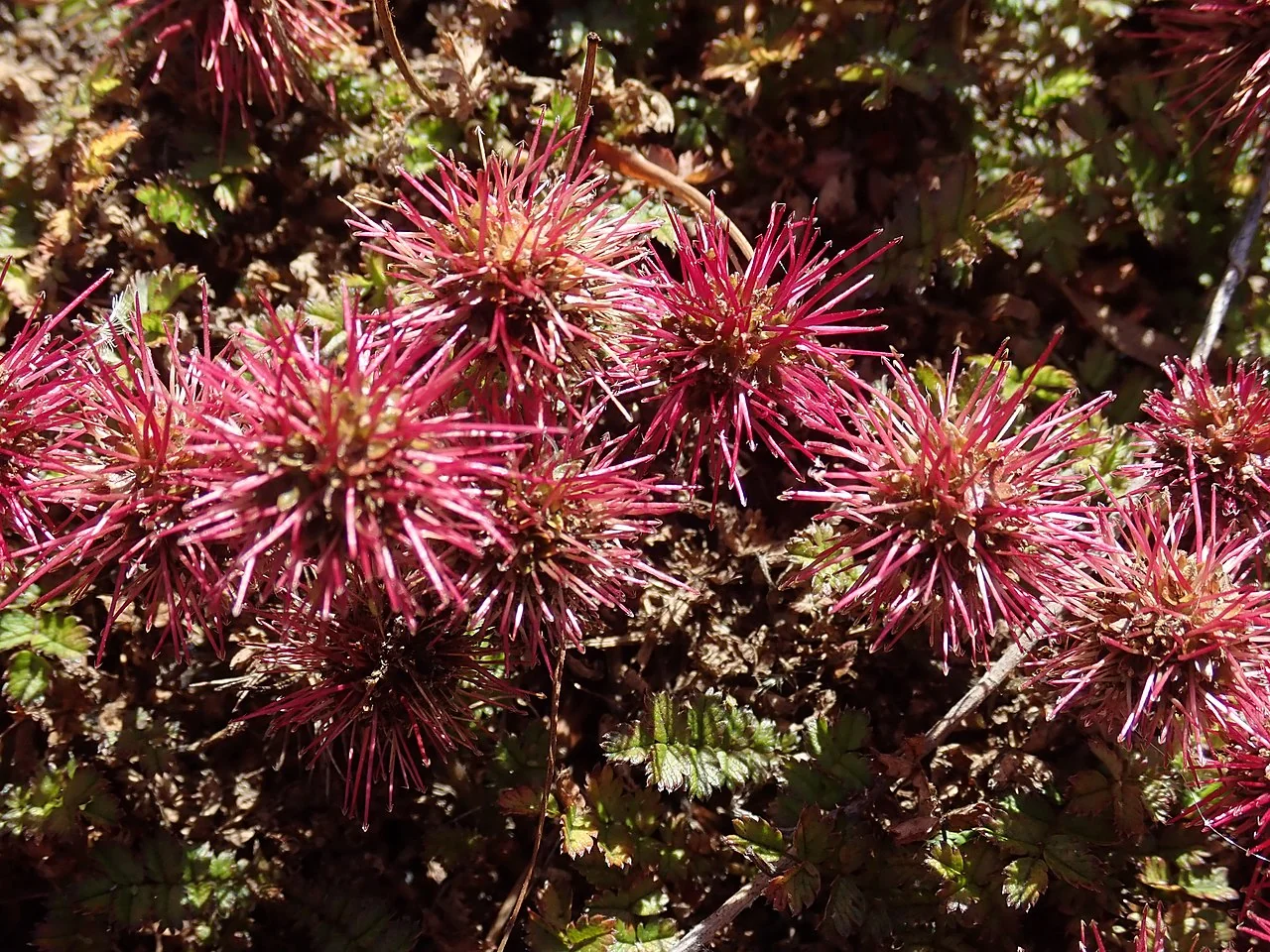
Black-Stemmed Fern
Polystichum richardii
A hardy fern forming handsome clumps; young fronds (pikopiko) have been traditionally eaten after blanching. Excellent for shaded gardens and forest margins. Learn more in our native plants guide .

Plant Description
Botanical Features
Black-stemmed Fern ( Polystichum richardii ), also known as the common shield fern, hard shield fern, or pikopiko, is a fern native to New Zealand. It is characterized by its dark green, harsh fronds, which can vary in appearance. The fronds typically measure 10-50 cm by 4-25 cm, and are supported by stipes (stalks) that are densely covered in narrow, blackish-brown scales. The plant can grow to a height of 0.6-1 meter and a spread of 0.8-1.5 meters. This fern is found in various habitats, from coastal areas to lowland forests and dry places. It is an evergreen fern that is hardy once established and prefers partial shade with evenly moist, well-drained soil. The young fronds of Polystichum richardii were traditionally eaten by the Māori people after blanching.
Quick Facts
Overview
| Scientific Name | Polystichum Richardii |
|---|---|
| Height | 0.6-1 m |
| Spread | 0.8-1.5 m |
| Light | Partial shade |
| Water Needs | Evenly moist, well-drained |
| Frost | Good |
| Frost Tolerance | Hardy once established |
| Salt Tolerance | Low; requires protection from salt exposure |
| Growth Rate | Slow to moderate |
| Lifespan | Long-lived perennial |
Climate Best Suited to
Regional climate suitability across major New Zealand cities.
Regional Suitability
| Whangārei | Ideal |
| Auckland | Ideal |
| Hamilton | Suitable |
| Rotorua | Suitable |
| Tauranga | Ideal |
| Gisborne | Ideal |
| New Plymouth | Ideal |
| Whanganui | Ideal |
| Palmerston North | Suitable |
| Napier | Ideal |
| Wellington | Ideal |
| Nelson | Ideal |
| Christchurch | Suitable |
| Dunedin | Suitable |
| Invercargill | Suitable |
| City | Climate Suitability |
|---|
Natural Habitat
Black-stemmed Fern ( Polystichum richardii ), also known as the common shield fern, hard shield fern, or pikopiko, is a fern native to New Zealand. It is widely distributed from coastal areas to montane regions, showcasing its adaptability to diverse environments.
Key Habitats Include:
- Forested Hillsides and Banks: It is commonly found on forested hillsides and banks, where it contributes to the understory vegetation.
- Coastal Cliff Faces: It thrives on coastal cliff faces, often under scrub, demonstrating its tolerance to maritime conditions.
- Drier Habitats: Unlike many other ferns, it can also be found in drier habitats, including open rocks and shrubland, indicating a degree of drought tolerance.
- Urban Environments: Its resilience allows it to extend its range into urban environments, appearing on roadside banks and cuttings.
Preferred Conditions:
- Light: While it generally prefers well-lit conditions, it is tolerant of shade, making it versatile for various light exposures within its habitat.
- Soil: For optimal growth, it thrives in well-drained, humus-enriched fertile soil.
The presence of Polystichum richardii in these diverse habitats underscores its ecological importance in contributing to the biodiversity and structural complexity of New Zealand's natural landscapes.
Plant Conservation
Conservation
Polystichum richardii , also known as the Black-stemmed Fern or Common Shield Fern (Pikopiko), is a native fern of New Zealand. It is now often referred to by its updated scientific name, Polystichum neozelandicum . Regarding its conservation status, Polystichum neozelandicum (encompassing what was formerly known as Polystichum richardii ) was assessed in 2023 and is classified as "Not Threatened" in New Zealand. This fern holds cultural and ecological significance in New Zealand, supporting native biodiversity and contributing to habitat structure. It is also valued for restoration and garden plantings. Polystichum richardii thrives in partial shade with well-drained, moisture-retentive soil, often found in forested hillsides, banks, and coastal cliff faces. It can also adapt to urban environments like roadside banks.
Growing Requirements
Soil
Well-drained, moderately fertile soils; avoid prolonged waterlogging.
Light
Performs in full sun to partial shade depending on species.
Water
Keep evenly moist while establishing; reduce irrigation as roots develop.
Temperature
Hardy in most regions of Aotearoa once established.
For Black-stemmed Fern ( Polystichum richardii ), choose a site with partial shade and soil that is well-drained, moisture-retentive. Incorporate composted organic matter to improve structure and drainage. Plant with the crown or root collar at soil level, then apply a 5-8 cm mulch to moderate temperature, conserve moisture, and suppress weeds. Protect young plants from extremes while establishing and consider the stated frost tolerance (seasonal) when siting near exposure or cold air drains.
Planting Guide
Best Planting Practices
Plant in humus-rich, free-draining soil in shade to part shade. Keep the crown at soil level and mulch with leaf litter to conserve moisture.
- Moisture: Evenly moist; avoid waterlogging.
- Soil: Leaf mould, compost, and fine bark over loam.
- Spacing: 60-90 cm for mature clumps.
Ecosystem Notes
- Bank stabiliser: Clumps help bind shallow soils.
- Understorey habitat: Shelter for invertebrates and seedlings.
- Associates: With tree ferns, Blechnum s.l., and nīkau in moist forests.
Uses and Significance
Garden and Restoration
A hardy fern forming handsome clumps; young fronds (pikopiko) have been traditionally eaten after blanching. Excellent for shaded gardens and forest margins.
- Shaded borders and forest gardens
- Understorey texture and ground cover
Propagate Black-stemmed Fern by division of established clumps in cool, moist conditions or by spores raised in sterile medium with bottom heat. Keep humidity high and air movement gentle to limit fungal issues while young fronds harden.
Cultural Significance
Cultural Importance
Fern Heritage
A resilient shield fern of dry, rocky places, often featured in native fern collections and education gardens that celebrate the diversity of New Zealand pteridophytes.
Polystichum richardii , commonly known as the common shield fern or pikopiko, holds cultural significance primarily in New Zealand. The young fronds of this fern, referred to as pikopiko, were traditionally consumed by the Māori people after being blanched. This hardy, evergreen fern is native to New Zealand.
Landscaping Ideas
- Shade borders: Mass for bold, glossy texture.
- Stream edges: Use above high-water line with consistent moisture.
- Fern gardens: Pair with Asplenium and tree ferns for layered fronds.
Seasonal Care Calendar
Spring
- Plant and mulch
- Protect new growth from weeds
Summer
- Deep watering in drought
- Monitor pests
Autumn
- Light formative pruning
- Top up mulch
Winter
- Plant eco-sourced stock
- Stake in windy sites
Pruning and Maintenance
Techniques and Timing
Generally minimal; formative work when young and removal of damaged wood.
Prune Black-stemmed Fern lightly to maintain structure; remove damaged shoots and avoid hard cuts on older wood.
How to Grow Black-Stemmed Fern
Black-stemmed Fern ( Polystichum richardii ) is a hardy, evergreen fern native to New Zealand, known for its distinctive black stipes (stems) and lush, dark green fronds. This elegant fern is well-suited for shaded, moist sites in gardens, woodland settings, or as a striking accent in containers. Its resilience and attractive appearance make it a popular choice for native plant enthusiasts and those looking to add a touch of natural beauty to their landscapes. Understanding its propagation methods is key to successfully cultivating this beautiful native fern.
From Spores
Propagating Black-stemmed Fern from spores is a fascinating and rewarding method, though it requires patience and attention to detail. Collect mature spores from the undersides of healthy fronds when they are dark brown and easily dislodge. Sow fresh spores in late winter to spring. Use a sterile, free-draining medium, such as a blend of peat and sand or a specialized fern-raising mix. Sow the spores thinly on the surface of the medium, without covering them, and keep the container in a sealed clear plastic bag or covered with a clear lid to maintain high humidity. Provide bright, indirect light at cool to mild temperatures (ideally 10-18°C). Germination is typically slow and irregular, often taking several weeks to months for the prothalli (gametophytes) to develop. Once the prothalli have formed and fertilization has occurred, tiny sporophytes (true ferns) will emerge. Carefully prick out crowded sporophytes into small cells or pots once true fronds appear, growing them on with good light and steady moisture. Gradually harden them off before planting out into their final positions.
By Division
Division of established clumps is an excellent and reliable method for propagating Black-stemmed Fern, especially for maintaining the genetic characteristics of a particularly attractive specimen or for rejuvenating older plants. This is best undertaken in early spring or autumn when the soil moisture is reliable and temperatures are moderate. Carefully lift the entire fern clump using a spade or fork. Gently separate the clump into smaller sections, ensuring that each division has several healthy fronds and a good network of roots. Replant the divisions immediately at the same depth as the original plant into prepared soil that is free-draining and rich in organic matter. Water thoroughly after replanting to settle the soil around the roots and keep the divisions evenly moist until new growth indicates successful establishment. This method is particularly effective for expanding existing plantings or for creating new plants with minimal effort.
Pests and Diseases
Common Problems and Solutions
- Frond scorch: Protect from hot, dry winds.
- Fungal spotting: Improve airflow; water at soil level.
- Slugs/snails: Protect new croziers in wet seasons.
Bonus Tip
Expert Growing Advice
Polystichum richardii , also known as the Black-stemmed Fern or Common Shield Fern (Pikopiko), is a hardy, evergreen fern that thrives in partial shade and well-drained, moist soil. Incorporating composted organic matter can significantly improve soil structure and drainage, making it an excellent choice for shaded gardens, forest margins, or even as a striking accent in containers. The young fronds of Polystichum richardii , commonly known as pikopiko, were traditionally eaten by the Māori people of New Zealand after blanching. Harvest pikopiko sparingly from multiple plants and only young, tightly coiled croziers to avoid weakening clumps.







